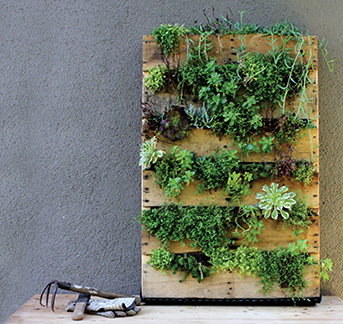Now, we all know that the quality of home-grown fruits and veggies is far superior to anything from the grocery store, but, sadly, not everyone has the space to lay out a large garden bed capable of feeding a family for half the year. After all, your backyard space is generally divided up into adult space, kid space and space for the family dog. Not much leftover for the veggies. But there is a space that many people overlook: the vertical space!
That’s right—you can grow UP.
Vertical gardening offers some benefits:
• Uses none of your grass space
• It’s portable and can be easily moved in case of inclement weather
• Reduces the stress on your back
• Decorates otherwise drab areas of your yard or house
And vertical gardening isn’t just for vegetables—you can also create walls of flowers to attract hummingbirds or bees!
There are so many building options for a vertical garden, including some that you can buy ready-made. But if you need to feed your inner-gardener, here are a few DIY ideas:
1. Wooden Pallets
alk about the ultimate in inexpensive recycling! Pallets are everywhere! You can find wooden pallets at all home improvement stores, grocery stores, even at printing companies. Most are set aside and just abandoned or thrown away, but ask the store manager before taking them.
Pallets are so versatile—they fit anywhere you have room. Secure them with brackets and lean them against your fence to help decorate it, or lean them against a bare spot on the wall of the house. They also help to enclose and decorate your deck if leaned against the railing.
While wearing a sturdy pair of work gloves, inspect the pallets to make sure they’re not made of pressure-treated wood (as the chemicals would leach into your plants) and that they’re in good condition. Once you get them home, remove any errant nails or splinters, then clean with water and a small scrub brush.
If you don’t trust the type of wood being used in pallets, and if your carpentry skills are up to the challenge, you can also build your own pallet garden by using weather-friendly cedar or redwood; although, this is quite a bit more expensive.
To help keep the soil inside use landscape fabric. Lay the pallet on a sturdy table, then stretch the landscape fabric on the inside back from the top to the bottom. Secure it using a staple gun. Make sure the bottom of the pallet is closed off with either the fabric or a piece of wood so that the soil won’t fall out of the bottom.
Once the landscape fabric is secure, turn the pallet over and cover the back with a thick, plastic sheet; this will act as a water barrier to protect your house or fence. After the plastic, cover the back with a thin piece of plywood to secure it.
Position the pallet in the spot you’ve chosen and secure it in place. Remember: It should be nearly vertical so that the soil can settle without falling out. Then begin filling in, starting at the bottom, using a mix of wet potting soil (the soil must be wet or it will fall out) and compost (hopefully you’ve had your compost bin going all winter).
Now, it’s finally time for the plants. Take advantage of the space and keep plants close together; stuff, stuff, stuff them in! Leafy plants, like spinach and lettuce, mixed in with wonderful herbs, such as oregano and basil! Mmmmm! (Hint: To help naturally control insects, mix in some basil, citronella grass or marigold plants.)
Once all of your plants are in place, make sure to water them generously. Check them periodically for the first several days, as watering will make the soil settle—you might need to add soil here and there.
2. PVC Pipe Dreams
So lightweight and easy to work with, PVC pipe is a great choice for a small space or even a balcony garden! It’s also an excellent choice for hydroponic gardening.
PVC is available at all home improvement stores (check the plumbing section), comes in many different sizes and thicknesses and can be attached to a balcony railing, hung on a fence or even made into a standalone vertical planter. And corner “elbow joints” allow you to connect pieces together and turn corners on railings.
Before buying your materials, plan your space and make a list of materials you’ll need; also consider what types of plants you want to grow. Smaller plants, such as herbs, will do well in pipes between 1.5” and 2.5” in diameter, but larger plants, like strawberries or tomatoes, will need pipe 4” wide or more.
PVC pipe is available in different lengths; your local home improvement center will usually cut your pipe to length for you if you ask. This will not only save you time later, but make transporting long pipes in your car much easier.
You’ll need to use a special drill bit in order to create holes large enough to accommodate your plants. If you don’t already own a drill or aren’t comfortable using power tools, consider calling a friendly neighborhood handyman to help you out. Once the holes are drilled, make sure to use a piece of sandpaper to sand down the rough edges of the holes. This will save your fingers later on during planting.
Depending on the design you’ve chosen, attach the pipes to your deck railing or fence, or place vertically in a very large pot. Once they’re secure, fill them with a mixture of potting soil and compost, then begin planting your seedlings—or seeds—in the holes. Make sure to water thoroughly. Check the soil periodically during the first few days and add more if necessary, as it tends to settle after watering.
3. Garden Pots and Buckets
Plastic pots and buckets are ugly and boring, but they’re also inexpensive and come in many different sizes.
Use three varying sizes of either pots or buckets and drill drainage holes in the bottom of each. Place a flattened coffee filter in the bottom of each pot/bucket, covering the holes; this allows drainage while preventing the soil from spilling out. Use the largest pot/bucket as the base, then put a smaller pot/bucket upside down on the inside center of the bottom container. This acts as a base for the next upright pot. Repeat this process for the middle container, creating a pyramid effect. Fill each upright container 3/4 full with potting soil, then place your seedlings (or seeds) along the outer edge of each.
By adding colorful plants, the ugly pots are instantly transformed!
4. Soda Pop of Color
Instead of throwing that empty 2-liter soda bottle in the recycling bin, give it one more chance to be useful!
Cut the bottle in half crosswise, then turn the top of the bottle upside down, so that the “neck” now sits in the bottom of the bottle. Fill the top portion with potting soil and your seedlings. When you water, the excess will spill into the bottom of the bottle.
5. This Idea’s a Shoe-In
If you’ve been cleaning out your closets and no longer need that cloth or vinyl multi-pair shoe hanger, recycle it by filling the shoe compartments with potting soil and creating an herb garden that’s guaranteed to fit all sizes!
Gardening is such a productive way to get fresh air and exercise—and, as it turns out, the ultimate in recycling; not to mention the added prize of fresh, healthy veggies. So, grab those pots that are sitting in the shed and anything else around the house that can be made useful again and start “growing up”!
Suzzanne Siegel is a graphic designer in St. Petersburg, FL, and an avid gardener.
Tips and Hints
• Don’t use garden soil in your planters—use only potting soil. It’s important to use the right soil and garden soil tends to compact too tightly; it’s also heavy and made for the yard. potting soil, on the other hand, is lighter because it contains perlite. This enables the plants to breathe and spread their roots easily, which allows them to grow larger. You can always add your own perlite into your personalized compost mix.
• Don’t put large plants on the top of your garden. Your first thought might be to plant tomatoes on the top of your pallet or PVC pipe to allow them to cascade down the sides, but this will only cause your smaller plants down below to be deprived of the water that they’ll need. This is especially true for vertical PVC gardens. Larger plants tend to “hog” all the water.
• Don’t hang your pallet garden on your fence posts. While this might seem like a great idea at first, you need to remember that your wooden pallet is already very heavy and becomes even more weighty when filled with dirt and plants. Don’t take the chance of letting your fence fall over!
Project Suggestions
• Herbs and Root Vegetables Tower Pot. If you want to grow root vegetables, such as carrots or parsnips, try planting them in a deep, wide pot, then include a vertical piece of PVC in the center of the pot to grow herbs.
• Strawberry Rails Forever. Use long lengths of PVC filled with strawberry plants and attach to either the top rail of your fence or deck railing. The strawberries will cascade down the side of the fence or deck. Easy pickin’s!
• A-Frame/Sandwich Board Garden. Make a free-standing A-frame by attaching hinges to the tops of two pallets (of the same height) and connecting them. Ensure its sturdiness by also attaching wooden braces to the sides, so that the finished piece looks like the letter “A.” This makes a lovely conversation piece, not to mention a nice, shady spot for your dog or cat!
• Add a bit of whimsy by including colorful crystals or rocks in between plants. Gnomes peeking out from in between the plants add a little magic to your potted plants, as well as silk butterflies or ladybugs attached to wires that are inserted into the dirt.





